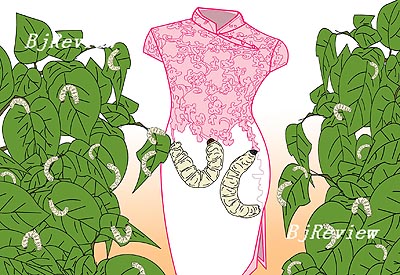|

China's most ancient gift to the world, silk, arrived long before gunpowder, paper and printmaking. This coveted fabric predated Christ and Buddha. Silk startled the world: Lenient ancient Romans banned it as sexy and immoral. Durable, useful and elegant, it is one of the oldest fibers known to man. Production remained a Chinese secret until 550 when two Nestorian monks, risking their lives, smuggled out silkworms hidden in bamboo canes. They presented the pupas to the Byzantine Emperor Justinian in Constantinople as tribute.
Silk's discovery as a weavable material is credited to Xi Ling Shi, the 14 year-old bride of Huangdi, legendary ruler and ancestor of the Chinese nation also known as Yellow Emperor. One day in 2640 B.C., according to the writings of Confucius, she was sitting under a mulberry tree, drinking a cup of tea. A silk cocoon fell smack dab into her teacup. The clever young woman noticed that the delicate fibers unraveled in the hot liquid. Lady Xi was thus the first to unravel a silk cocoon and then use the filament to create yarn to weave cloth. This romantic legend does indeed correlate with the earliest written references to silk production in China.
"When I was a little kid we kept silk worms for fun," my coworker Qing Xiaohua told me one afternoon. "It was cool, watching these tiny eggs hatch into worms, and gathering mulberry leaves to feed them. My grandfather raised them on flat woven baskets that he stacked up in the corner. We kept them in our house and fed them all the time. They were ravenous, ugly, squirming creatures."
I almost couldn't believe Qing at first when she explained that silk, this lustrous soft fiber I love to wear, is made by a blind, flightless moth that excretes stuff out of a special tube in its head. "Only the Chinese would have figured that out, with their meticulous attention to detail and nature," I thought. But other insects also produce silk from webs and cocoons. Today spider silk is used commercially for weapons and telescope cross hairs and other optical instruments.
"A silk moth is large and useless. It lays 500 pinhead sized eggs in about five days and then dies," my friend quietly explained. "One ounce of eggs produces 30,000 larvae, and they consume a ton of raw mulberry leaves for a grand total of 12 pounds of silk. We didn't have that many but our neighbors did. They stacked up the worms in a special shed, and fed them until they started climbing on sticks to spin their cocoons. Afterwards my neighbors steamed the room to kill the worms and then unraveled this silk by hand. Now they have machines."
"In Beijing, or anywhere in large cities in south China, especially Suzhou or Hangzhou, my hometown, you can buy good quality silk cloth and clothing very cheaply," Qing continued. "China exports a great deal of silk but I know where to shop for the good stuff. We'll go to Beijing's Silk Market, called Xiushui. It's on Chang'an Avenue near the Yong'anli Subway Station. There used to be a Silk Alley but the government put up a building in 2005 and expanded the kinds of things that could be sold. The alley was full of privately owned shops; the new government building rents booths to vendors."
We walked in this no-frills multi-storied edifice. Vendors of all ages started screeching like eager vultures. "Friend, come here, buy these soft silk blouses! Give you best price…" Merchants had much more for sale than silk. Many goods seemed cheap and of dubious quality. I saw loads of stuff: cashmere sweaters, down jackets, leather purses and shoes, weird hats, knockoff watches and the usual array of brass and wood trinkets. Several booths displayed fake brands: Gucci, Dior, Maxmara, Valentino; the list was endless. No prices are set--everything is negotiable. The vendors were hungry and rapacious, clutching at my arms and wiggling provocatively.
"Ignore them," Qing stated firmly, gripping my elbow and heading me decisively toward the escalators. "They are low quality, some are fakes and all are overpriced. You show me what you'd like; I'll come back alone and purchase it for you. These people make a killing on dumb foreigners. Keep your wallet in your bra; the thieves are thick here."
I found exactly what I wanted: red silk panties and six yards of cobalt blue dress fabric. Qing noted my choices; we exited and had a splendid lunch. A week later she presented a bill and the silk items. "It's less than a third of the original prices," I exclaimed.
"That's why you need good friends in China," she answered with a grin. "For both business and pleasure."
The Tao of SilkThe author is an American journalist living in Beijing |
